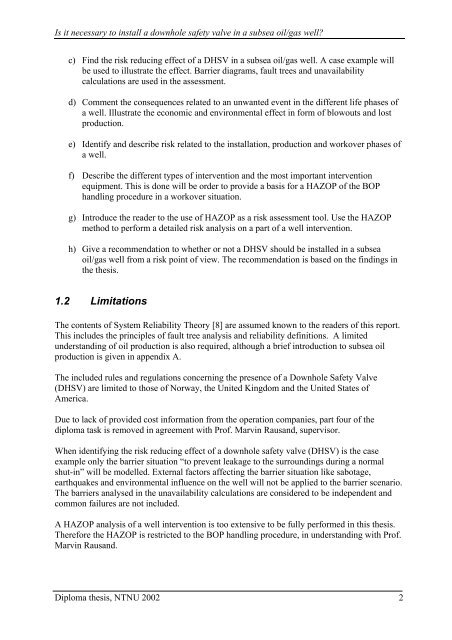Is it necessary to install a downhole safety valve in a subsea ... - NTNU
Is it necessary to install a downhole safety valve in a subsea ... - NTNU
Is it necessary to install a downhole safety valve in a subsea ... - NTNU
Create successful ePaper yourself
Turn your PDF publications into a flip-book with our unique Google optimized e-Paper software.
<strong>Is</strong> <strong>it</strong> <strong>necessary</strong> <strong>to</strong> <strong><strong>in</strong>stall</strong> a <strong>downhole</strong> <strong>safety</strong> <strong>valve</strong> <strong>in</strong> a <strong>subsea</strong> oil/gas well?<br />
c) F<strong>in</strong>d the risk reduc<strong>in</strong>g effect of a DHSV <strong>in</strong> a <strong>subsea</strong> oil/gas well. A case example will<br />
be used <strong>to</strong> illustrate the effect. Barrier diagrams, fault trees and unavailabil<strong>it</strong>y<br />
calculations are used <strong>in</strong> the assessment.<br />
d) Comment the consequences related <strong>to</strong> an unwanted event <strong>in</strong> the different life phases of<br />
a well. Illustrate the economic and environmental effect <strong>in</strong> form of blowouts and lost<br />
production.<br />
e) Identify and describe risk related <strong>to</strong> the <strong><strong>in</strong>stall</strong>ation, production and workover phases of<br />
a well.<br />
f) Describe the different types of <strong>in</strong>tervention and the most important <strong>in</strong>tervention<br />
equipment. This is done will be order <strong>to</strong> provide a basis for a HAZOP of the BOP<br />
handl<strong>in</strong>g procedure <strong>in</strong> a workover s<strong>it</strong>uation.<br />
g) Introduce the reader <strong>to</strong> the use of HAZOP as a risk assessment <strong>to</strong>ol. Use the HAZOP<br />
method <strong>to</strong> perform a detailed risk analysis on a part of a well <strong>in</strong>tervention.<br />
h) Give a recommendation <strong>to</strong> whether or not a DHSV should be <strong><strong>in</strong>stall</strong>ed <strong>in</strong> a <strong>subsea</strong><br />
oil/gas well from a risk po<strong>in</strong>t of view. The recommendation is based on the f<strong>in</strong>d<strong>in</strong>gs <strong>in</strong><br />
the thesis.<br />
1.2 Lim<strong>it</strong>ations<br />
The contents of System Reliabil<strong>it</strong>y Theory [8] are assumed known <strong>to</strong> the readers of this report.<br />
This <strong>in</strong>cludes the pr<strong>in</strong>ciples of fault tree analysis and reliabil<strong>it</strong>y def<strong>in</strong><strong>it</strong>ions. A lim<strong>it</strong>ed<br />
understand<strong>in</strong>g of oil production is also required, although a brief <strong>in</strong>troduction <strong>to</strong> <strong>subsea</strong> oil<br />
production is given <strong>in</strong> appendix A.<br />
The <strong>in</strong>cluded rules and regulations concern<strong>in</strong>g the presence of a Downhole Safety Valve<br />
(DHSV) are lim<strong>it</strong>ed <strong>to</strong> those of Norway, the Un<strong>it</strong>ed K<strong>in</strong>gdom and the Un<strong>it</strong>ed States of<br />
America.<br />
Due <strong>to</strong> lack of provided cost <strong>in</strong>formation from the operation companies, part four of the<br />
diploma task is removed <strong>in</strong> agreement w<strong>it</strong>h Prof. Marv<strong>in</strong> Rausand, supervisor.<br />
When identify<strong>in</strong>g the risk reduc<strong>in</strong>g effect of a <strong>downhole</strong> <strong>safety</strong> <strong>valve</strong> (DHSV) is the case<br />
example only the barrier s<strong>it</strong>uation “<strong>to</strong> prevent leakage <strong>to</strong> the surround<strong>in</strong>gs dur<strong>in</strong>g a normal<br />
shut-<strong>in</strong>” will be modelled. External fac<strong>to</strong>rs affect<strong>in</strong>g the barrier s<strong>it</strong>uation like sabotage,<br />
earthquakes and environmental <strong>in</strong>fluence on the well will not be applied <strong>to</strong> the barrier scenario.<br />
The barriers analysed <strong>in</strong> the unavailabil<strong>it</strong>y calculations are considered <strong>to</strong> be <strong>in</strong>dependent and<br />
common failures are not <strong>in</strong>cluded.<br />
A HAZOP analysis of a well <strong>in</strong>tervention is <strong>to</strong>o extensive <strong>to</strong> be fully performed <strong>in</strong> this thesis.<br />
Therefore the HAZOP is restricted <strong>to</strong> the BOP handl<strong>in</strong>g procedure, <strong>in</strong> understand<strong>in</strong>g w<strong>it</strong>h Prof.<br />
Marv<strong>in</strong> Rausand.<br />
Diploma thesis, <strong>NTNU</strong> 2002<br />
2


